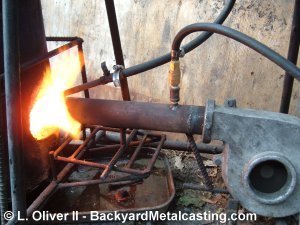 Vs.
Vs. This page is a comparison between melting iron in a crucible with a waste oil burner and melting iron in a cupola with coal or coke. Overall these two methods are the most practical and economical ways for a hobbyist to melt iron. The best attributes are in green text, while the drawbacks are in red text. - Aug./10/2007
Other matchups; Charcoal Vs. Propane | Propane Vs. Waste oil | Used motor oil Vs. Used cooking oil.
 Vs.
Vs. | Oil to fuel the furnace must usually be obtained from outside sources even when collected from them for free. | Cupola furnaces can be run off homemade hardwood charcoal making you completely self sufficient in terms of fuel. |
| An oil fired furnace can melt large chunks of iron as long as they fit in the crucible. | Cupola furnaces require the metal to be broken into fairly specific size pieces or they won't melt properly. |
| A waste oil burner can have your iron ready to pour within 30-40 minutes of ignition. | Many cupolas require a preheat time of up to an hour for the first charge of iron to preheat before any melting can begin. |
| In general iron melts slower in a crucible even with a strong oil burner. | After the first batch of metal melts each seceding batch of metal can usually be poured in 8-10 minutes. |
| An oil fired furnace's iron melting capacity is mostly limited only by the size of crucible available or that can fit inside the furnace. | Cupolas are generally limited to a set amount of iron per batch based on their bore size. |
| Unless a crucible breaks iron is not likely to freeze in a oil fired furnace. | Iron can easily freeze in the cupola well or tap hole sometimes requiring major work to remove it. |
| An oil fired furnace requires a crucible to hold the metal. Crucibles can be expensive. | A cupola does not require a crucible. |
| An oil fired furnace can be short and compact like most other crucible furnaces. | Cupolas are narrow but they are usually tall which can make them more challenging to move. |
| If the oil burner malfunctions it can produce a lot of smoke. | Unless the cupola is burning dirty coal there is little to no smoke from it. |
| After the iron melt you shut off the burner and you're done. | After the iron melt you have to clean ash, coals, hot slag and leftover iron from inside the furnace. |
| Summary: If you need large individual loads of iron or a few occasional pours then a waste oil fired furnace is a great way to go. However if you need multiple, rapid iron pours per melting session and each individual pour doesn't need to be very large than a cupola is a great option. A cupola is especially valuable when molds are being made continuously by several people and then poured as soon as they are ready. |
|